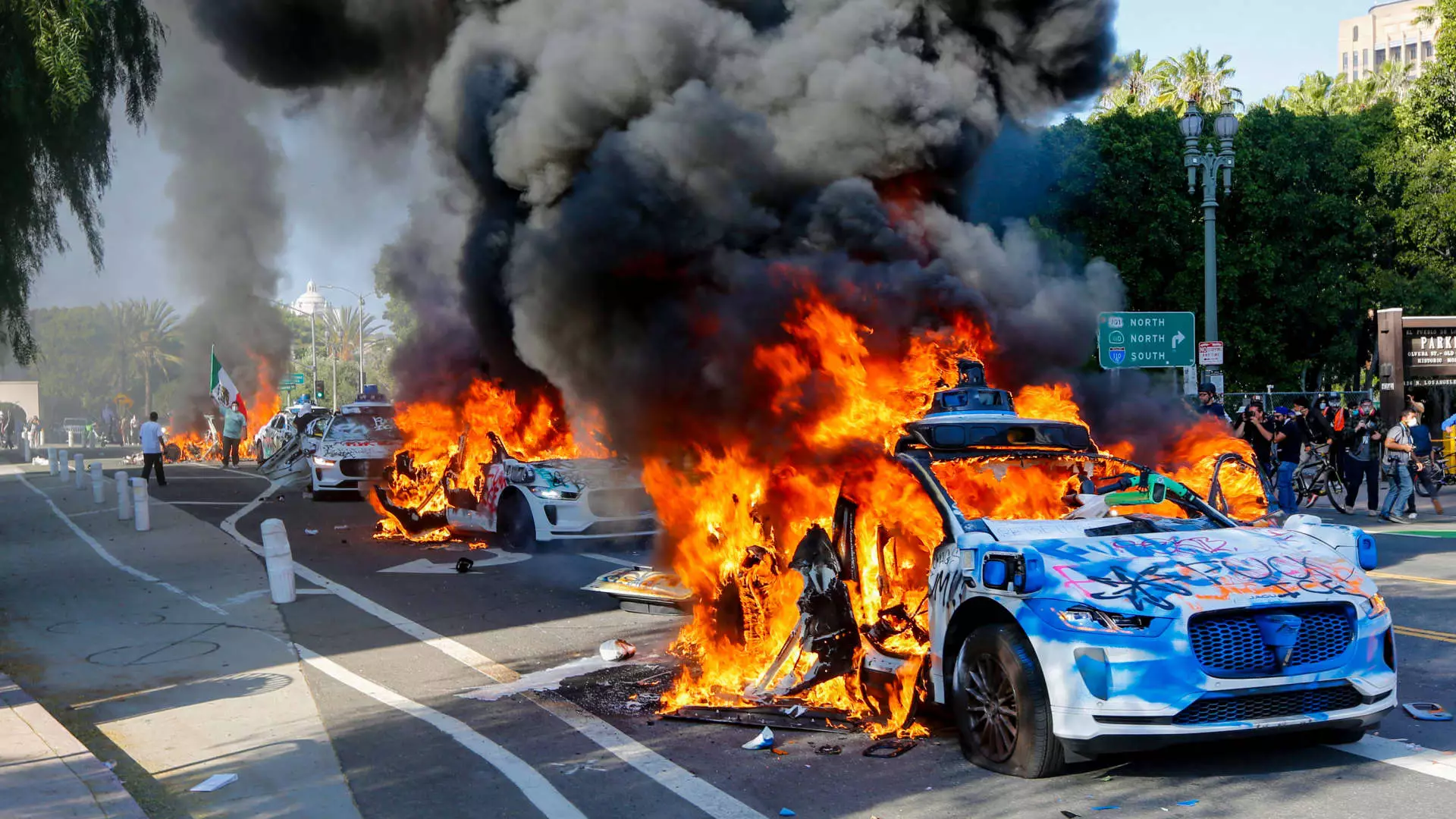In a disturbingly vivid manifestation of societal tensions, several Waymo self-driving cars were torched in downtown Los Angeles during protests against President Donald Trump’s aggressive immigration policies. This incendiary action served as a stark reminder of the boiling frustrations among communities grappling with changing federal regulations and their often devastating consequences. The flames that engulfed these vehicles were not mere acts of vandalism; they were incendiary symbols of a collective outcry and urgency that has defined American social movements in recent years.
These demonstrations, which began peacefully, escalated into tension-filled confrontations between law enforcement and protesters over the weekend. Significantly, the presence of the California National Guard added an ominous tone to the situation. With Governor Gavin Newsom publicly challenging the federal government’s overreach—claiming that federalizing the National Guard is an unconstitutional maneuver—this incident exposes the rift not just between state and federal governance but also between technology and the communities it affects.
Autonomous Vehicles: A Target in a Broader Political Landscape
The vandalism of Waymo’s vehicles, laden with graffiti and set aflame, represents an unnerving intersection of technological advancement and genuine human concern. While the implications of autonomous vehicles promise convenience and efficiency, they also evoke fears of job losses, economic disparity, and surveillance. As Waymo’s robotic taxis—a shining example of innovation funded by Alphabet—roll through our streets, they inadvertently become unwitting participants in socio-political conflicts.
It’s crucial to dissect the peculiar nature of these protests; they haven’t merely erupted in response to immigration enforcement but are symptomatic of a larger malaise that permeates through many levels of society. Here lies the paradox: while technology strives to create a seamless, efficient future, it often blinds itself to the pressing needs and realities of human lives it impacts. The perceived elitism of tech giants like Waymo—offering robotaxi rides in affluent areas—contrasts sharply with the struggles faced by marginalized communities, which can lead to reactions as desperate as the flames that consumed those vehicles.
The Litmus Test of Societal Readiness
The arson of these autonomous vehicles serves as a grim litmus test as to whether society is truly ready for the shift that driverless transportation heralds. This shift is anchored not solely in technical feasibility but also in a larger dialogue about equity, ethics, and awareness. Self-driving cars could ease traffic congestion, lower accident rates, and transform urban planning—yet if they come at the expense of community security, their promise risks crumbling under societal backlash.
Amid the riots, accusations flew from the highest offices about threats of arrest against political figures challenging immigration policies, stoking the flames of anger further. This admixture of personal prosecutorial vitriol and auto-destruction encapsulates a potent critique: Are we concurrently advancing technology while regressing in our social obligations? The burning of vehicles extends beyond mere protest; it’s a manifestation of anger aimed at perceived oppression and systemic disregard from those in power.
Waymo’s Response: A Moment of Reflection
Waymo’s decision to halt its services during the protests—while prudent—highlights a fundamental existential quandary for tech companies venturing into human-centric domains. How can they redefine their role? As they navigate service disruptions in a socially and politically charged atmosphere, they must grapple with the implications of operating in an environment fraught with unrest and dissent. Addressing safety concerns alongside building community trust will require more than top-down approaches; it demands genuine engagement with citizen voices.
As the protests continue to make waves across the globe, technology companies like Waymo must reassess their narratives and positioning. For many, the self-driving car represents convenience; for others, it symbolizes a widening chasm between the privileged and the disenfranchised. The onus of shaping a future that integrates technological advancement and equitable social structures lies not just with fractured political entities, but also within the hearts of those who wield the power of innovation. We must ask ourselves in this liminal space: How can technology evolve while lifting society as a whole, rather than illuminating its fractures?

Leave a Reply